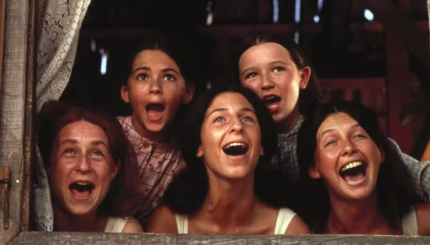Reprinted by permission of the author from Four Centuries of Jewish Women’s Spirituality: A Sourcebook (Beacon Press).
Conceiving a child did not come easily to me. Neither did the words to convey my frustration, despair, and uncertainty to those who might have helped. But stories have been a source of strength and nourishment to me since I was a little girl. I devoured the books of the Brothers Grimm and Andrew Lang like hills of chocolate chip cookies. Myths of the Greek gods and goddesses were more substantial, like roasted meat with gravy. In later years, I began to feast on the tales of my biblical ancestors. When my life has presented a problem or paradox, I have sought a solution in close study of the sacred text.
I learned to do this by studying the midrash, collections of rabbinic interpretations and parables which aim to clarify particular aspects of the Tanakh [Bible]. One of my teachers, Judah Goldin, explained that when the rabbis found something in the text that disturbed them, from a grammatical deviation to a perplexing character flaw, they responded with a midrash.
A Miscarriage Creates a Sense of Imbalance
When I lost my first pregnancy after trying to conceive for a prolonged period of time, my sense of living harmoniously with Nature was sufficiently disturbed to impel me to make a midrash in response. This midrash would be a hybrid creature, part story, part ritual.

Help us keep Jewish knowledge accessible to millions of people around the world.
Your donation to My Jewish Learning fuels endless journeys of Jewish discovery. With your help, My Jewish Learning can continue to provide nonstop opportunities for learning, connection and growth.
Nobody I knew well had ever lost a baby. I had heard horror stories of friends of friends and their pregnancies-turned-nightmares, but these were remote occurrences. When Death came to our household, my husband and I had only each other. Our parents (the grandparents-to-be) seemed puzzled and overwhelmed by this tragic break from the norm. They wanted to help, but how could they give us a live child? While I was in the hospital recovering from the laparotomy that removed the Fallopian tube where the pregnancy had been trapped, phone calls and visitors kept coming. But when I was finally settled once more at home, I looked at my husband, Steve, and asked: What do we do now? How do we start to live again?
A Miscarriage is Like a Death
What nobody could tell us was that we had experienced the real death of a potential being. We were grieving, but we could not put words to it; we could not invite people over to sit shiva [the intense mourning that occurs during the first seven days after the death of a close relative] for our dead baby. Then I remembered all those disgusting dead-baby jokes I used to hear in fifth grade. Humor fills the vacuum caused by taboo. Talking about and mourning for the death of an abstract being, one that was never held or touched, was taboo in our society and in Judaism.
This was intolerable to me. I had to find a way to mark this death or I would be grieving for the rest of my life. In the works of Elizabeth Kubler-Ross I discovered the notion that one’s own experience with Death is the instructor to follow. I would look into my tradition to find what to do. I remembered the story of Hannah and Peninnah in the First Book of Samuel.
Studying the Story of Hannah
Hannah was the favorite wife of Elkanah, but she was unable to bear him any children. Peninnah, her co-wife, less favored, bore one healthy child after the other. Through much suffering, deliberation, humiliation, and prayer, Hannah was finally blessed with a son whom she named Samuel.
Here was my model. Hannah had lost hope and self-esteem. She even displayed symptoms of severe depression: She stopped eating and wept constantly (I Samuel 1:7-8). This indicated how deeply she was mourning for the child she might never have.
Like Hannah I was paralyzed-by infertility and by my recent pregnancy loss. The rabbis considered Hannah the paradigm of heartfelt prayer and unceasing faith. Therefore, I would consider her story to be a kind of prayer, an inspiration to survive this overwhelming period of loss and despair that was facing me. Accordingly, in the year following my pregnancy loss, I sat down daily with the story of Hannah and studied it from every possible angle. Each day I read another verse and pondered it. Then I read commentaries on the story, mostly in Pesikta Rabbati, to see what the rabbis thought about Hannah and her rival, Peninnah. Finally I wrote a new version of the story, a synthesis of the original text, its commentaries, and my identification with Hannah through the experience of infertility.
The ritual of studying Hannah’s story became a [prayer in praise of God recited daily by mourners] that I said each day for my dead child. In this way I was able to live through the loss instead of being consumed by it. Incidentally, my husband’s response was quite different. Whereas I turned inward to find strength and renewed faith by studying texts, he used activity to overcome the loss and became a Jewish Big Brother. One year after the death, we created a joint ritual. [This ritual is described in Penina V. Adelman, “Playing House: The Birth of a Ritual,” Reconstructionist, January-February 1989.] Before this could happen, however, we needed to do some individual preparation.
The more I studied, the more convinced I became that there was a ritual hidden there if I could only see it. However, this ritual lived between the lines of Hebrew text. No older wise woman was going to teach the ritual to me. Thus, part of the interpretive process would be uncovering this ritual for infertility.
My need to look into the sacred texts of my tradition in search of solace and hope echoed my desire to look life straight in the eye again after losing my baby and to find meaning in the experience. Magical thinking led me to believe that by studying Hannah intensely I would ingest some of her strength and that this strength was contained in the very letters of her story. Similar reasoning often lies behind the activity of study. The wachnact, or “night of watching” before a brit milah [circumcision] when there is communal study all night long to protect the newborn from the Angel of Death, is a folk custom that illustrates the notion of study as a form of Jewish worship–just as Torah readings in the synagogue during the week, on the Sabbath and [on] holidays do.
In addition, the tefillin [phylacteries] and mezuzah [parchment scrolls in containers placed on doorposts in a Jewish home], which contain Hebrew prayers, may be seen as types of amulets protecting those who use them. Thus, I believed that the study of Hannah’s story might protect me from further loss and offer some guidance in becoming a mother.
Ritual Grows From Hannah’s Silent Prayer
Hannah’s silent prayer became the basis of the ritual. It represented the silence of all those who had experienced such losses and could find no place within Judaism to mark them. By studying Hannah and identifying with her, I became another link on a chain of women who had had difficulty in conceiving or had lost children. This chain included all the matriarchs and extended back as far as Lilith (Adam’s first wife, who was condemned to lose all her babies as they were born because she refused to submit to Adam’s will). In this ritual, giving voice to the silence would be my goal.
I first sang and told the story of Hannah in my Rosh Chodesh [the beginning of a new Jewish month] group composed of women only, a safe forum for the initial public exposure of my experience. Then on the one-year anniversary of the pregnancy loss, I performed the story as the haftarah [prophetic reading] on the first day of Rosh Hashanah, the time when Hannah’s story is traditionally read.
Presenting my midrash in public before a group of men and women meant the experience was no longer my burden and my husband’s alone. At last, I understood my compulsion to develop a ritual where there had been none. Ritual places personal experience in the public realm where it may be witnessed, dealt with, and shared. The loss of a child, potential or real, becomes bearable when the person sitting to your right and the person sitting to your left experience it with you and can say, “Finally I understand.”


